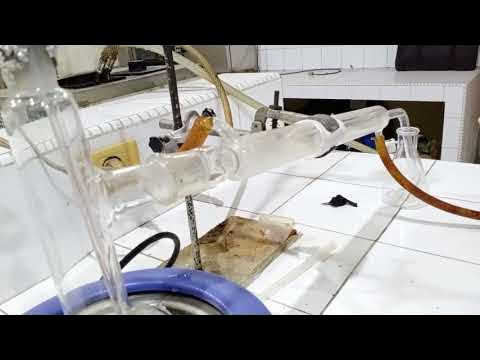Making esters - Part 1 | Chemistry Tutorial
Summary
TLDRIn this chemistry lab at Curtin University, Alexandra Young demonstrates the production of ethyl ethanoate through esterification, a process used in perfumes and artificial flavorings. The video covers safety considerations, the addition of reactants like ethanol and acetic acid, and the use of sulfuric acid to shift equilibrium. It details steps including reflux, separation, drying with calcium chloride, and purification via distillation, culminating in measuring the yield of the fragrant ester.
Takeaways
- 🧪 The video is a chemistry lab demonstration by Alexandra Young, a lecturer at Curtin University, focusing on the synthesis of ethyl ethanoate.
- 🍾 Esters, like ethyl ethanoate, are known for their fragrant and fruity odors, making them useful in perfumes, nail polish removers, and artificial flavorings.
- 🔥 Safety is paramount; flammable alcohols and corrosive carboxylic acids are used, requiring precautions against fire and skin contact.
- 🌡 The esterification reaction is an equilibrium process, influenced by factors like reactant concentrations and the removal of water to shift the equilibrium towards product formation.
- 🧪 The use of sulfuric acid as a dehydrating agent helps remove water, a byproduct that would otherwise reduce the yield of ethyl ethanoate.
- 🔄 The setup for the reaction includes a round bottom flask, boiling chips for even heating and to prevent glassware cracking, and a reflux condenser for efficient product recovery.
- ♨️ Heating the reaction mixture under reflux facilitates the esterification process by speeding up the reaction and using the boiling points of reactants to prevent loss.
- 💧 After the reaction, water is added to the separating funnel to help isolate the product, as ethyl ethanoate is not water-soluble and will separate into a distinct layer.
- 🧪 Sodium carbonate is used to neutralize any leftover acetic acid or sulfuric acid, facilitating the separation of the organic layer containing the product.
- 🌟 Calcium chloride is added to the product to remove any residual water, ensuring the purity of ethyl ethanoate before the final purification step.
- 🔬 The final step involves distillation to purify the product based on differences in boiling points, with the collection of the fraction below 80 degrees Celsius being the pure ethyl ethanoate.
Q & A
What is the main objective of the chemistry lab session at Curtin University?
-The main objective of the lab session is to make ethyl ethanoate through processes such as esterification, isolation, and purification.
Why are esters often used in perfumes, nail polish remover, and artificial flavorings?
-Esters are used in these applications because they are very fragrant and often have fruity odors, making them ideal for scenting and flavoring purposes.
What safety considerations are mentioned for the experiment involving alcohols and carboxylic acids?
-The safety considerations include the flammability of alcohols, requiring them to be kept away from flames, and the corrosiveness of carboxylic acids, necessitating avoidance of skin contact.
What is the role of sulfuric acid in the esterification reaction?
-Sulfuric acid acts as a dehydrating agent, removing water from the reaction mixture, which according to Le Chatelier's principle, shifts the equilibrium to the right and increases the yield of the ester product.
Why are boiling chips added to the reaction setup?
-Boiling chips are added to provide a surface for bubbles to form, preventing the glassware from cracking due to bubble formation, and to ensure even heating of the reaction mixture.
What is the purpose of heating the reaction mixture under reflux?
-Heating under reflux speeds up the reaction by increasing the temperature and using a catalyst. It also prevents the loss of reactants and products with low boiling points by condensing the vapors back into the reaction mixture.
How is the product ethyl ethanoate isolated from the reaction mixture?
-Ethyl ethanoate is isolated by adding water to a separating funnel, shaking the mixture, and then running off the bottom layer, leaving the product in the top layer due to its lower density.
What is the purpose of adding sodium carbonate to the reaction mixture after the esterification reaction?
-Sodium carbonate is added to neutralize any leftover acetic acid or sulfuric acid present in the reaction mixture, facilitating the separation of the organic layer containing the product.
How is the presence of water in the product addressed during the purification process?
-Water is addressed by adding calcium chloride to the product, which reacts with any remaining water, causing it to clump and stick to the bottom of the container, thus separating from the organic product.
What is the final step in the purification process of ethyl ethanoate?
-The final step is distillation, where the product is transferred into a round bottom flask, heated, and the fraction below 80 degrees is collected, which is the purified ethyl ethanoate.
How is the yield of the product determined at the end of the experiment?
-The yield is determined by measuring the volume of the collected distillate in a measuring cylinder and then calculating the percentage yield based on the theoretical yield.
Outlines

This section is available to paid users only. Please upgrade to access this part.
Upgrade NowMindmap

This section is available to paid users only. Please upgrade to access this part.
Upgrade NowKeywords

This section is available to paid users only. Please upgrade to access this part.
Upgrade NowHighlights

This section is available to paid users only. Please upgrade to access this part.
Upgrade NowTranscripts

This section is available to paid users only. Please upgrade to access this part.
Upgrade Now5.0 / 5 (0 votes)





